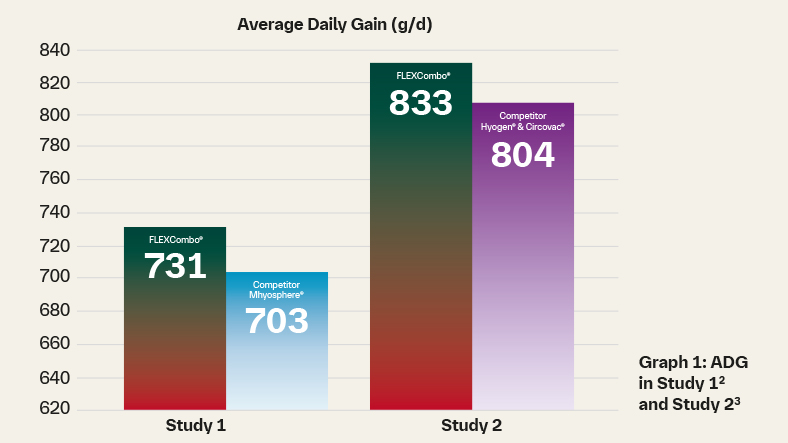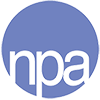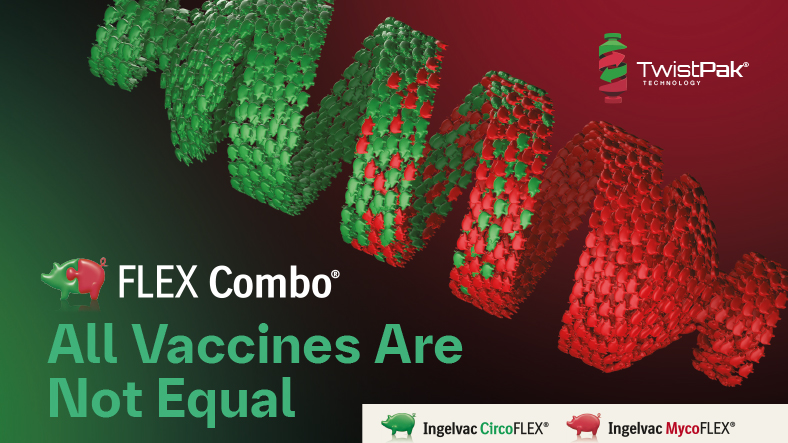Improving health can reduce your costs as well as your carbon footprint by optimising performance whilst reducing inputs, such as feed and electricity1 and the brand of vaccine you choose could make more of a difference than you realise.
Good biosecurity remains one of the key pillars to prevent pathogen spread within farms as well as between farms with vaccines representing an essential part of disease control. Vaccines train the immune system to recognise and destroy specific pathogens that, when left unchecked, can cause disease with reduced performance as a result.
Disease causing pathogens are many and can affect the health of your pigs in a variety of ways, some have a direct impact on the immediate health/productivity of the animal, whereas others can have negative impacts beyond the initial and obvious signs.
Porcine Circovirus type 2 (PCV2), can directly cause issues such as wasting pigs, increased mortality or subpar performance. PCV2 also reduces the ability of the immune system to respond to other disease challenges, making it more difficult to overcome infection and thus likely increasing medicine use and poor productivity.
Vaccination against PCV2 in general greatly helps to minimise or even eliminate the effects of PCV2 infection. Recent studies2,3,4,5 indicate however that not all vaccines are equal, and the brand of vaccines used can have a pronounced effect on productivity and, by extrapolation, on the costs and carbon footprint of that enterprise.
Performed in the UK, two separate studies compared the efficacy of FLEXCombo® (Ingelvac CircoFLEX® mixed with Ingelvac MycoFLEX®) to that of different Mycoplasma hyopneumoniae plus PCV2 vaccines that are routinely used on farm.
In both studies FLEXCombo® outperformed the competitors with a better finishing weight (more than 3kg difference2,3) and an increased wean-finish average daily gain (ADG) of over 28g/d, this was an increase of 4.1%2 (Study 1 vs Mhyosphere®) and 3.6%3 (Study 2 vs Hyogen® mixed with Circovac®).

“Health and management are two of the main components that drive pig performance.”
This means that weight for weight, animals vaccinated with FLEXCombo® will be finished quicker, reducing inputs, and thus cost of production.
In Study 1 there was also a marked difference in mortality2. FLEXCombo® vaccinated pigs had a 6.5% lower mortality than the pigs on Mhyosphere®, which meant that fewer resources were wasted overall, thus lowering that herd’s carbon footprint if FLEXCombo® were to be used routinely.
In economic terms for Study 1, completed in 2022, using FLEXCombo® saved the producer £10.23/pig (based on average feed costs, pig price and FCR for wean-finish herd as per AHDB and average euro-pound exchange rate in 20226) calculated using BECALpig7.
Also, in Study 1 smaller pigs group4, the difference and spread of the daily weight gains at transfer (13 weeks of age) was obvious with the small pigs on the competitor product showing slower growth (-22.4g/d) and more variability4 (graph 2).

The benefit of better uniformity at this stage is that management in the finishing accommodation is much easier8 and is likely to result in a more uniform pig going to slaughter, which plays a major role in profitability9.
The reduced performance in the nursery found in Study 1, with pigs vaccinated with Myhyosphere®, was also demonstrated in all pigs vaccinated with Hyogen® and Circovac® in Study 25.
All pigs shared the same airspace and all medical treatments in both trials, other than the Mhp + PCV2 vaccines, were the same.
However, with the information we have, there are a few possibilities to explain this difference in the nursery (and thus wean-finish) performance.
All pigs were exposed to the same pathogens at the same time, thus there could simply be a difference in how well the vaccines do their job. This could be due to differences in the antigen (the pathogen or parts of the pathogens) and/or the adjuvant in the vaccines (the ingredient designed to direct a specific immune response to the antigen) resulting in the consistent differences in efficacy.
Authors have described in several publications10,11 a difference in the production of acute phase proteins (APP), proteins produced as a response to injury, disease or stress, depending on the vaccine used. These publications demonstrated a much higher production of APP in the Hyogen® and Circovac® vaccinated piglets, than in piglets vaccinated with FLEXCombo®.
So why could this be important? APP are a sign that the body is fighting an insult, which is essential for fighting off disease and repair of wounds for example. During this process, several physical reactions happen such as fever, decreased feed intakes and decreased intestinal motility amongst others.
The higher the levels of APP, the more clinical signs you are likely to see. And this comes at a cost because the pigs are producing proteins that are not used for growth and are thus not making the best use of the feed they eat. So high APP levels after vaccination are not productive.
In both those publications about APP production, the authors also demonstrated a much higher body temperature post vaccination for at least 24 hours in the Hyogen® + Circovac® pigs. In one of those studies there was a much better daily gain in the FLEXCombo® pigs 24h after vaccination, likely reflecting better feed intakes.
Whilst they did not measure feed intakes, if animals have a fever, they will not eat as much as they would normally do. And as we’ve all read in the “Maximising Pig Health” August supplement of Pig World, making sure that stress is minimised around weaning and feed intakes maximised, maybe this temporary episode after vaccination with certain products makes all the difference for the lifetime performance. Or maybe it’s a combination of both better protection and gentle adjuvant that explains the better performance of FLEXCombo® vaccinated pigs?
Will all vaccines help protect your pigs’ health and your income? Yes, if compared with unvaccinated pigs, but there is a big difference how well the different vaccine brands will do the job. There is a reason Ingelvac CircoFLEX® is still ranked number one pig vaccine sold globally12.
To evaluate how well the vaccines are helping your pigs and help you make money, you need to use a vaccine proven to improve performance on multiple clinical parameters consistently and measure the performance of your pigs, the more precisely the better.
Download Information (opens as PDF)
References
- Pig World August Supplement (2025): Maximising Pig Health: p 18.
- Huelsmann-Diamond and others (2023). Results of a field study comparing the efficacy of 2 combined Mycoplasma hyopneumoniae plus PCV2 vaccines administered via needle free devices. ESPHM IMM-PP-47
- Strachan and others (2025). Comparative efficacy in wean to finish female pigs of two freshly mixed Mycoplasma hyopneumoniae plus PCV2 vaccines given at weaning. ESPHM IMM-PP-27
- Huelsmann-Diamond and others (2023). Results of a field study comparing the efficacy between 2 combined Mycoplasma hyopneumoniae plus PCV2 vaccines administered via needle free devices in small pigs at weaning. ESPHM IMM-PP-39
- Strachan and others (2025). Comparative efficacy of 2 freshly mixed Mycoplasma hyopneumoniae plus PCV2 vaccines administered at weaning in nursery pigs. ESPHM IMM-PP-21
- https://www.exchangerates.org.uk/GBP-EUR-exchange-rate-history.html
- https://www.preventionworks.info/becal-pig-calculator
- Patience and others (2004). Variation: costs and consequences. Proc of the Banff Pork Seminar Adv Pork Prod.15:257–66.
- López-Vergé and others (2018). Strategies to improve the growth and homogeneity of growing-finishing pigs: feeder space and feeding management. Porc Health Manag 4, 14
- Fernandez-Aquilar and others (2019). Effects of acute phase proteins in Iberian breed piglets of two different Circovirus type 2 and Mycoplasma hyopneumoniae vaccine protocols. ESPHM IMM-PP-22
- Figueras and others (2023). Effects on acute phase proteins in piglets of two different Pcv-2 and Mycoplasm hyopneumoniae vaccination protocols. ESPHM IMM-PP-29
- Q1 2025 Ceesa data ranking




